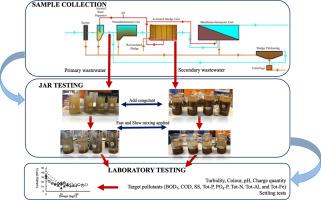Journal of Environmental Management ( IF 8.7 ) Pub Date : 2020-06-26 , DOI: 10.1016/j.jenvman.2020.111002 Annaliza Cainglet 1 , Axumawit Tesfamariam 1 , Elisangela Heiderscheidt 1

|
In municipal wastewater treatment, inorganic coagulants (IC), e.g. polyaluminium chloride (PAC), are normally used to remove pollutants such as dissolved and particulate nutrients, in a process called coagulation/flocculation. However, IC use has been linked to issues e.g. in effluent water post-treatment, sludge management and disposal (IC increase sludge volume and metal concentrations in sludge), etc., raising uncertainties about their overall cost-efficiency and environmental benefits. In this study, the suitability of organic coagulants (OC) as sole precipitation agents to replace IC (PAC) was investigated. A total of 10 synthetic (i.e. polyDADMACs and polyamines) and semi-natural (chitosan, starch, and tannin-based) OC products were tested in treatment of samples from primary sedimentation and secondary sedimentation stages of municipal wastewater treatment, and their performance was compared with that of PAC. The study was conducted using the jar test methodology. The coagulants were tested for their ability to remove target pollutants (e.g. BOD7, COD, SS, tot-P, PO4-P, tot-N) and form rapidly settling flocs. In general, higher (up to 60%) coagulant doses were needed in treatment of secondary wastewater samples than primary samples. In comparison with the OC doses required for effective treatment, the PAC doses were higher (up to 80%). In treatment of secondary wastewater samples, OC with high molecular weight (MW) and high charge density (CD) (e.g. pAmine1) achieved best removal of target pollutants (e.g. 72% SS, 87% PO4-P, 88% BOD7), followed by PAC. In treatment of primary wastewater, PAC performed best (removing e.g. 96% SS, 96% PO4-P), closely followed by chitosan and polyamine products. Based on these results, polyamine products with high MW and (very) high CDs have the potential to act as the sole precipitation agent in both primary and secondary stages of municipal wastewater treatment. Further research is needed to determine the effect of residual coagulant on downstream water and sludge treatment processes (e.g. activated sludge process, sludge dewatering, etc.).
中文翻译:

有机聚电解质是市政废水处理中的唯一沉淀剂。
在市政废水处理中,通常将无机凝结剂(IC)(例如聚氯化铝(PAC))用于凝结/絮凝的过程中,以去除污染物,例如溶解的营养物和颗粒状养分。然而,离子色谱的使用已与废水后处理,污泥管理和处置(离子色谱增加污泥量和污泥中金属浓度)等问题相关联,从而增加了其总体成本效益和环境效益的不确定性。在这项研究中,研究了有机凝结剂(OC)作为唯一沉淀剂替代IC(PAC)的适用性。总共10种合成的(即polyDADMAC和多胺)和半天然的(壳聚糖,淀粉,对单宁和基于单宁的)OC产品进行了处理,以处理市政废水处理的一级沉淀和二级沉淀阶段的样品,并将其性能与PAC进行了比较。该研究使用广口瓶测试方法进行。测试了混凝剂去除目标污染物(例如BOD)的能力如图7所示,COD,SS,tot-P,PO 4 -P,tot-N)并形成快速沉降的絮凝物。通常,与次要样品相比,次要废水样品的处理需要更高(最高60%)的凝结剂剂量。与有效治疗所需的OC剂量相比,PAC剂量更高(高达80%)。在处理二次废水样品中,高分子量(MW)和高电荷密度(CD)的OC(例如pAmine1)实现了目标污染物(例如72%SS,87%PO 4 -P,88%BOD 7)的最佳去除。,其次是PAC。在处理一次废水中,PAC表现最好(例如去除96%SS,96%PO 4-P),紧随其后的是壳聚糖和多胺产品。根据这些结果,具有高分子量和(非常)高CD的多胺产品有潜力在市政废水处理的初级和次级阶段充当唯一的沉淀剂。需要进一步的研究来确定残留凝结剂对下游水和污泥处理过程(例如活性污泥过程,污泥脱水等)的影响。


























 京公网安备 11010802027423号
京公网安备 11010802027423号